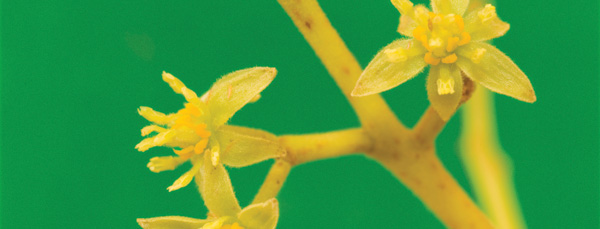Extracts

Genetics Research Provides Insights About Flowering Plants
By Danielle Torrent
Flowering plants have evolved at explosive rates throughout history, yet scientists since Charles Darwin have been faced with the great biological mystery of how they originated.
A new University of Florida study published in December in the Proceedings of the National Academy of Sciences presents the deepest insight to the genes that made up the first flower, the common ancestor of all flowering plants, and how those genes have changed over time.
“Our survival depends on products we get from the flower — grains, fruits and many other materials,” said Doug Soltis, UF distinguished professor of biology and project co-investigator. “Crop improvement is so important, but you don’t understand how a flower is put together unless you have a reference point — you can’t modify what you can’t understand.”
After nearly 10 years of research funded by the National Science Foundation, scientists from the Florida Museum of Natural History, the UF Department of Biology and the UF Genetics Institute are bringing the study to a close.
“There are 350,000 species of flowering plants (or angiosperms), and they serve as the foundation of nearly all of Earth’s ecosystems, yet we don’t know how the flower originated,” said Pam Soltis, UF distinguished professor, Florida Museum of Natural History curator and project co-investigator. “We now know the origin of many of the genes responsible for making a flower and how those genes have changed during the history of angiosperms.”
A 2009 UF study traced the origin of flowers using genetic data for the avocado (a representative of one of the early lineages of flowering plants) and a well-known plant in genetics research, Arabidopsis thaliana. The new study includes additional comparisons with a water lily, California poppy and cycad (a gymnosperm or non-flowering seed plant) and shows how the first flowers evolved from pre-existing genetic programs in gymnosperm cones.
“We have a much better understanding of the flower than we did 10 years ago and it’s a huge improvement,” Doug Soltis said. “We don’t know every pathway, but we have a much better handle on what makes those parts tick.”
Typical angiosperms have flowers with four organs: sepals (typically green), petals (typically colorful), stamens (male organs, which produce pollen) and carpels (female organs, which produce eggs). But in the earliest flowers, the distinct borders between their floral organs fade to a blur. The flowers of early angiosperms have organs that merge into each other — for example, a stamen of a water lily produces pollen but it may also be petal-like and colorful.
“Our study found that the floral organs of basal angiosperms merge not only in appearance but also in their underlying genetic pathways,” Pam Soltis said. “During evolution, the timing and location of where these genes act have become restricted, ultimately producing flowers with separate and distinguishable flower parts.”
“These missing links are incredibly important,” Doug Soltis said. “They are our key to the past.”
The study was a collaboration of researchers at UF, Penn State, the University of Georgia and the University at Buffalo. The first author on the paper is Andre Chanderbali, a postdoctoral student at the Florida Museum and the UF Department Of Biology.